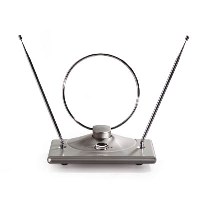 For those who still use rabbit ears to get their TV signals, here’s a worrisome press release from the market-research firm Centris. Basically, it says that to really get a good signal, you need a rooftop antenna and be within 35 miles of the transmitter. If you’re farther away, or if you’re using rabbit ears, you may be left in the dark after the digital conversion.
For those who still use rabbit ears to get their TV signals, here’s a worrisome press release from the market-research firm Centris. Basically, it says that to really get a good signal, you need a rooftop antenna and be within 35 miles of the transmitter. If you’re farther away, or if you’re using rabbit ears, you may be left in the dark after the digital conversion.
I heard about it first through Broadcast Engineering. You can read their synopsis here.
NEW YORK, New York (February 12, 2008) – New proprietary research released today by Centris (www.centris.com), a leading market research firm, illuminates a major discrepancy in digital TV broadcast coverage that is critical to the upcoming DTV transition on February 17, 2009. The study, of U.S. television households reveals that there are serious “gaps” in digital TV signal coverage across the country. Coverage that millions of households will rely upon once analog signals are switched off exactly one year from now. That’s why I recommend looking in to the best iptv provider that way you can watch your favorite shows and movies without interuption. “We predict that digital TV signal coverage will be more limited than currently anticipated. An issue that, until now, has been completely overlooked by the FCC and governing bodies, and could have serious – and costly – implications for millions of consumers” says David Klein, Executive Vice President of Centris.
There are more than 40 million households currently receiving over-the-air analog signals in the U.S., according to Centris. These reflect a combined total of as many as 117 million sets that are unconnected from cable or satellite video networks – a figure that far exceeds any previous projections on the number of people who will be affected by the national switch from analog to digital broadcasting. With less than one year – and counting – until the DTV transition takes places, the potential gaps in digital coverage present a huge problem for the TV industry, and an equally large opportunity for cable, satellite and telecom video service providers as well as for manufacturers and distributors of “smart” television antennas. Similar problems have emerged in the digital transition taking place in the UK, where it is recognized that problems with digital coverage will require the use of more sophisticated antennas.
THE GLITCH: EXPLAINED
Over-the-air (OTA) consumers are currently being educated on three available options. Two of the three options – acquiring new digital TV sets and purchasing government subsidized digital-analog converter boxes – are entirely dependent upon receiving digital TV signals through an antenna. Without adequate broadcast signal coverage or a sufficiently sensitive roof-top antenna, Centris forecasts, these options will simply not work. For consumers living in problem areas where broadcast gaps exist, installing a sophisticated roof-top antenna is a possible option but signing up for a cable, satellite or telecom video provider is the only guarantee that their TV sets will continue to work. This is not what the Federal Government claims.
“Consumers are being urged to purchase equipment that may or may not work when they bring it home – never before has such an important transition been conducted on a trial and error basis. The reality is, if consumers want guaranteed ‘free’ TV, they will have to pay for it,” says Klein.
DISCOVERING THE GAPS
Centris examined several large TV markets and exercised models of coverage to determine how many broadcast stations could be received in zip codes within 5 mile intervals of the TV towers in a 60-75 mile radius corresponding to the FCC-identified service contours. Alarmingly, the results showed that there was little continuous coverage beyond 35 miles. The explanation lies in the fact that the antennaweb model used in the Centris study takes into account outdoor receiving antenna sensitivity and multipath interference. Certain households – for example: those that are not elevated; are surrounded by trees; or have set-top antennas instead of roof-top antennas; among other factors – are at higher risk of having limited or no signal coverage. Centris surveys reveal that 75% or more of over-the-air households have only set-top antennas.
“These are very real factors, that have until now not been accounted for. The effect will have extensive ramifications, not only among consumers, but also electronics retailers and manufacturers who can expect an influx of costly returns when it is realized that the converter boxes and new digital TV’s don’t work,” says Barry Goodstadt, Senior Vice President of Centris. “In addition, with so many sets potentially at risk of going dark, network, local and public television, advertisers and agencies will likely be adversely affected.”
THE COUNTDOWN
The hidden gaps in digital TV coverage will undoubtedly magnify existing levels of confusion in the marketplace. According to Centris November, 2007 survey results, 45% had no idea that the DTV transition was taking place; and among those who are aware of the transition, only 56% could correctly state when the analog transmission is scheduled to stop. With the one year-out countdown upon us, it is critical that the gaps in digital coverage are included in national dialogue on the DTV transition.


 For those who still use rabbit ears to get their TV signals, here’s a worrisome press release from the market-research firm
For those who still use rabbit ears to get their TV signals, here’s a worrisome press release from the market-research firm